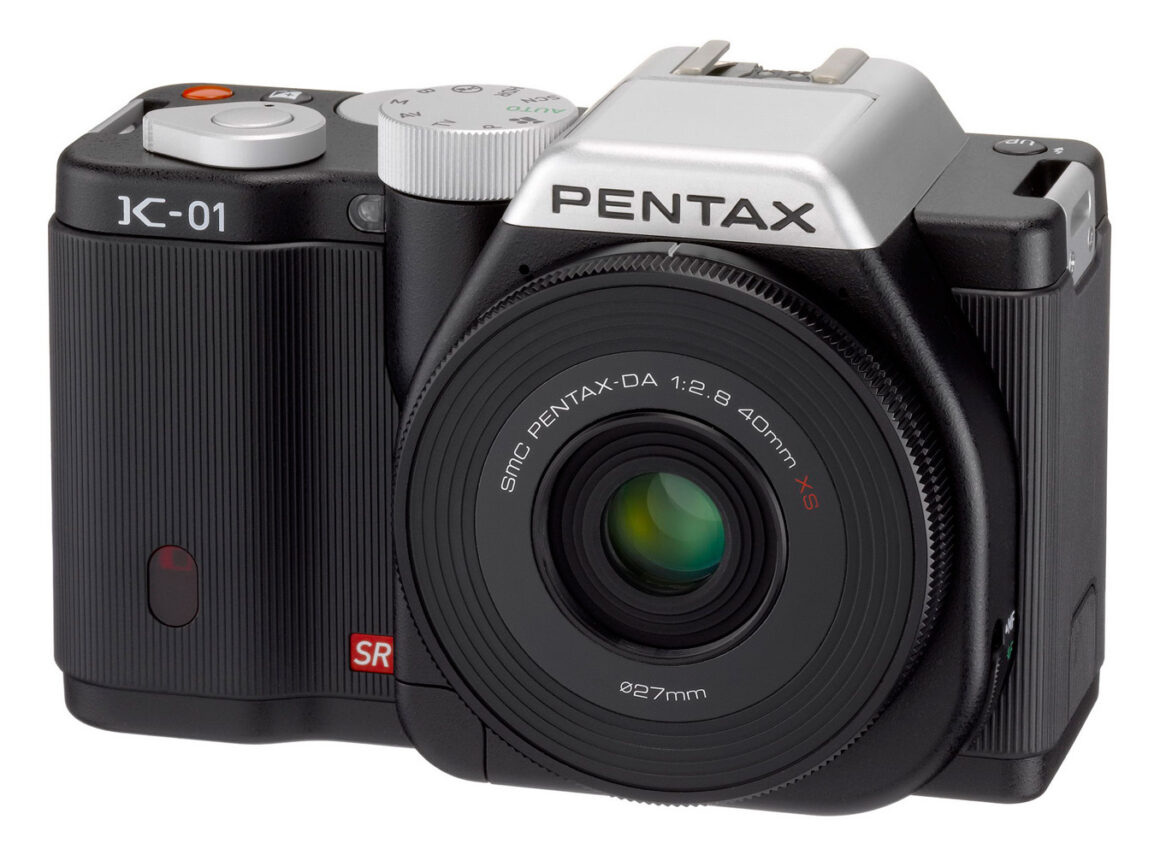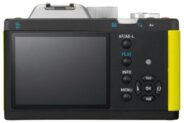Pentax K-01
APS-C AF digital mirrorless camera
Specification
| Production details: | |
| Announced: | February 2012 |
| System: | - |
| Format: | |
| Maximum format: | APS-C |
| Imaging sensor: | 23.7 × 15.7mm CMOS sensor |
| Resolution: | 4928 × 3264 - 16 MP |
| Crop factor: | 1.52x |
| Sensor-shift image stabilization: | Yes |
| Mount and Flange focal distance: | Pentax K [45.5mm] |
| Shutter: | |
| Type: | Focal-plane |
| Model: | Electronically controlled |
| Speeds: | 30 - 1/4000 + B |
| Exposure: | |
| Exposure metering: | Through-the-lens (TTL), open-aperture |
| Exposure modes: | Programmed Auto |
| Aperture-priority Auto | |
| Shutter-priority Auto | |
| Manual | |
| Physical characteristics: | |
| Weight: | 560g |
| Dimensions: | 121x79x59mm |
Manufacturer description #1
DENVER, CO February 2, 2012…When is a camera more than a photographer’s tool? The answer is when it’s an object designed by Marc Newson, one of the most acclaimed and influential contemporary designers.
PENTAX RICOH IMAGING AMERICAS CORPORATION introduces the Marc Newson designed PENTAX K-01* interchangeable lens camera (ILC). The new PENTAX K-01 is another bold effort from the manufacturer that is known for pushing camera size, color, durability, and now, design, to the limit. Widely known for designing a wide range of objects from furniture and household products to bicycles, cars, aircraft and yachts, Marc Newson has had collected works displayed in The Museum of Modern Art (MoMA) in New York City and many other major museums.
The contemporary, timeless K-01 houses a full array of advanced functions and user-friendly features in a camera body with remarkable form and function. The elimination of an optical viewfinder and quick-return mirror gave Newson more freedom in designing the camera body, and the K-01 showcases Newson originality in every detail. Available in black, white and Newson’s signature yellow colors, the K-01 features the designer’s autograph logo stamp on the bottom of each camera.
The famed designer’s touch also is evident in a new smc PENTAX-DA 40mm F2.8 XS interchangeable lens. As the world’s thinnest interchangeable lens,* the new 40mm combines with the PENTAX K-01 camera body to deliver a unique ILC system that is perfect for photographers who are as keen on design as they are on performance. Together, the K-01 and 40mm lens system mark the intersection where high technology and high design meet.
Key features of the PENTAX K-01 include:
- Durable machined aluminum frame under a stylish black, white, or yellow exterior.
- PENTAX mirrorless body design is compatible with 25+ million PENTAX K-mount lenses spanning decades.
- Large 16 megapixel APS-C sized CMOS image sensor with low noise image capture and multiple aspect ratios.
- Bright, high resolution 3 inch LCD with 920,000 dots.
- Full HD 1080p video capture at 30 FPS with h.264 compression (60 FPS at 720p) features outstanding video capture flexibility.
- Sensor-shift PENTAX Shake and Dust Reduction system is compatible with every mounted PENTAX lens.
- Fast 6 FPS burst mode is ideal for fast-action photography.
- Flexible ISO range of 100-25600 ensures gorgeous noise-free imaging in any lighting condition.
- Focus peaking mode provides fast and accurate manual focusing for critical focus applications.
The K-01 will be available in yellow, black and white in March 2012 for $749.95USD (body only) and $899.95USD (lens kit including new DA 40mm XS) in Marc Newson designed packaging and with the Marc Newson designed strap. The smc PENTAX-DA 40mm F2.8 XS unifocal interchangeable standard lens will ship at the same time for $249.95 USD.
Manufacturer description #2
February 2, 2012 - PENTAX RICOH IMAGING COMPANY, LTD. is pleased to announce the launch of the PENTAX K-01 lens-interchangeable digital camera. This new, stylish camera was designed in collaboration with one of the world’s most acclaimed designers, Mr. Marc Newson.
In response to the ever-growing digital camera market, PENTAX RICOH IMAGING COMPANY, LTD. has taken a number of major steps in the development of digital SLR cameras as attractive, user-friendly imaging tools. These include a camera offering a choice of 120 lens-and-body color combinations, and concept models designed in collaboration with various firms and artists. The new PENTAX K-01 is another bold effort in camera design, developed in line with Mr. Newson’s three design themes — a TIMELESS, TRUSTY and TOUCHABLE. At the same time, it provides the full array of advanced functions and user-friendly features expected from digital SLR cameras. The optical viewfinder and quick-return mirror were eliminated to allow more freedom in designing the camera body. The result is a camera that shows Mr. Newson’s originality in every detail, with meticulous attention paid to all body parts to faithfully reproduce his designs. His design scheme has also been applied to the new smc PENTAX-DA 40mm F2.8 XS unifocal interchangeable standard lens — the world’s thinnest interchangeable lens,* to be launched in the market simultaneously with the PENTAX K-01 camera body — to make the lens-mounted K-01 a complete design package.
The PENTAX K-01 comes with outstanding basic specifications, including sharp, high-resolution images captured by approximately 16.28 effective megapixels, high-speed burst shooting, an extra-wide sensitivity range with a top sensitivity of ISO 25600 (when expanded), and Full HD video recording. In addition, it features the reliable, ever-popular PENTAX K lens mount, so users can make effective use of their entire lens stock — even lenses produced for film-format SLR cameras. While the K-01 makes the perfect choice for start-up digital interchangeable lens camera photographers looking for an easy-to-operate camera, as well as those who demand originality and stylishness from their imaging tool, it also can be a wonderful second camera for current PENTAX digital SLR users who find pleasure in totally new photographic styles that only the K-01 can offer.
* The world's thinnest interchangeable lens for lens-interchangeable digital cameras, as of February 1, 2012 (based on PENTAX' research).
Design concept of PENTAX K-01 by Marc Newson
- A modern digital camera with a contemporary yet timeless design.
- The camera body is compact and trim whilst preserving all the functions of a professional camera.
- The lines are clean and simple creating an elegant graphical composition.
- The materials convey quality and honesty.
- Machined aluminium and natural rubber provide the user with a tactile and durable piece of technology.
TIMELESS, TRUSTY, TOUCHABLE
Major Features
1. Immaculate, tasteful design by Marc Newson
The PENTAX K-01’s body consists of neat, straight lines to optimize both functionality and visual attractiveness. Original-design push buttons and control levers are efficiently laid out across the body, while brilliant colors are used on two key buttons for instant recognition: red for the video recording button, and green for the functional green button. The mode dial and the power switch are made of high-quality aluminum alloy, while the memory card slot and connectors on the comfortable, easy-to-hold grip are covered with protective rubber. What’s more, Mr. Newson’s original design scheme is evident in all elements of the K-01, including the product logo, the camera strap (included) and even the start-up screen that comes on when the K-01’s power is turned on.
2. Exceptional image quality assured by digital SLR camera system
The PENTAX K-01 comes equipped with a newly developed CMOS image sensor measuring 23.7 millimeters by 15.7 millimeters. With approximately 16.28 effective megapixels, this extra-large sensor assures high-speed readout of image data signals. The K-01 also features the new “PRIME M” imaging engine to assure first-rate movie recording performance in a digital interchangeable lens camera. It also offers an extra-wide sensitivity range — from ISO 100 to ISO 12800, or to ISO 25600 when expanded using a custom function — while minimizing annoying digital noise at all sensitivity levels.
3. Compatibility with all PENTAX lenses
The ability to change lenses is a great benefit of the digital interchangeable lens camera system. That’s why the PENTAX K-01 is designed to accept a wide array of PENTAX interchangeable lenses,** including those produced for film-format SLR cameras. Thanks to this lens compatibility, the user can choose a most suitable lens for a particular subject or scene and create the desired visual effect and perspective with great ease.
** K-, KA- KAF, KAF2, and KAF3- mount lenses can be used with the PENTAX K-01, while screw-mount lenses, 645-system lenses and 67-system lenses can be used with an adapter. Some functions may not be available on certain lenses.
4. High-quality video recording
The PENTAX K-01 comes equipped with a Full HD video-recording function to capture high-quality movie clips (1920 x 1080 pixels). With the H.264 recording format, it offers a choice of frame rate (30, 25 or 24 frames per second) to accommodate user-specific applications. It also comes with two new features to facilitate video recording: Red button for instant pushbutton start, and a stereo microphone for more realistic sound. While adding personal touches to recorded clips using various Custom Images, or recording the subject in a series of video clips using the interval movie shooting mode. The PENTAX K-01 also comes with an HDMI type C terminal, which allows the user to simultaneously output both Full HD movie clips and stereo sound, as well as an external microphone input terminal.
5. New-generation HDR mode
The HDR (High Dynamic Range) mode, which produces one extra-wide-gradation composite photo from three images taken at different exposure levels, has been upgraded to create a greater range of visual expressions. This upgraded HDR mode can be instantly selected with a turn of the mode dial. The user can take advantage of newly added features to select one of three exposure increments as well as the level of effects, while an automatic position adjustment function assures precise alignment of three images even when they are taken with a handheld K-01.
6. A selection of image processing tools for personalized expressions
The PENTAX K-01’s Custom Image function allows the user to select the most appropriate finishing touch for a particular subject or scene to express the photographer’s creative intention or taste. Included in 11 Custom Images are: Bleach Bypass to create a dramatic visual effect used in motion pictures, and Cross Process to produce a fanciful image with unusual colors. The K-01 also features 19 distinctive digital filters — including Miniature, which turns an actual scene into an image full of miniature models — to easily apply different visual effects to recorded images. The user can be even more creative and imaginative by applying multiple digital filters to a single image.
7. Smooth, quiet, high-speed burst shooting
The PENTAX K-01’s high-speed burst shooting mode comes in handy when preserving the action of fast-moving subjects in a series of images, since it captures up to six images per second. With its mirrorless construction, K-01 also offers exceptionally silent mechanical operation incomparable to existing PENTAX digital SLRs that allows user to concentrate on to photography even when shooting such subjects as stage performances.
8. Large, wide-angle 3.0-inch LCD monitor with approx. 921,000 dots
The PENTAX K-01 features a large, easy-to-view, high-resolution 3.0-inch color LCD monitor with approximately 921,000 dots. Its wide-view design assures a clear view of the monitor from approximately 170 degrees horizontally and vertically, making it particularly useful in low- and high-angle shooting.
9. PENTAX-original SR mechanism for sharp, blur-free images
The PENTAX K-01 incorporates the PENTAX-developed SR (Shake Reduction) mechanism. Usable with all compatible lenses, including those produced for film-format SLR cameras, this mechanism produces sharp, blur-free images even under demanding conditions that are prone to camera shake, such as when using a telephoto lens, shooting in the dark without flash illumination, or capturing landscapes in the twilight.
10. Effortless, user-friendly Auto Picture and Scene modes
The PENTAX K-01 features the PENTAX-original, user-friendly Auto Picture mode, which selects the most appropriate shooting mode for a given subject or scene from Portrait, Landscape, Macro and other distinctive shooting modes, while optimizing all camera settings, such as aperture, shutter speed, white balance, saturation, contrast and sharpness. As the result, the photographer can concentrate on image composition and shutter opportunity. The K-01 also offers 19 different Scene modes, which simplifies the photographing of difficult subjects or demanding scenes — such as Night Scene Portrait mode, Pet mode, and Backlight Silhouette mode — simply by choosing the corresponding icon on the camera’s LCD monitor.
11. Other features
- TTL image-sensor metering, with a choice of multi-segment, center-weighted and spot modes
- Contrast-detection autofocus system, with 81 selectable focus points
- DR (Dust Removal) mechanism to shake off dust adhering to the surface of the CMOS image sensor
- CTE white-balance control mode to emphasize the predominant color of a particular scene, such as the sunset
- A choice of four image sizes (4:3, 3:2, 16:9 and 1:1) to accommodate different subjects and applications
- Multi-exposure mode (up to nine exposures on a single image), with an auto exposure compensation function
- Interval shooting mode, useful in time laps recording of landscapes and flowers/plants from an exact same location and angle
- Compatibility with the new-standard SDXC and UHS Speed Class 1 memory cards
- SILKY Developer Studio 3.0 for PENTAX RAW-data development software (developed by Ichikawa Soft Laboratory) included; in-camera RAW-data development also available




